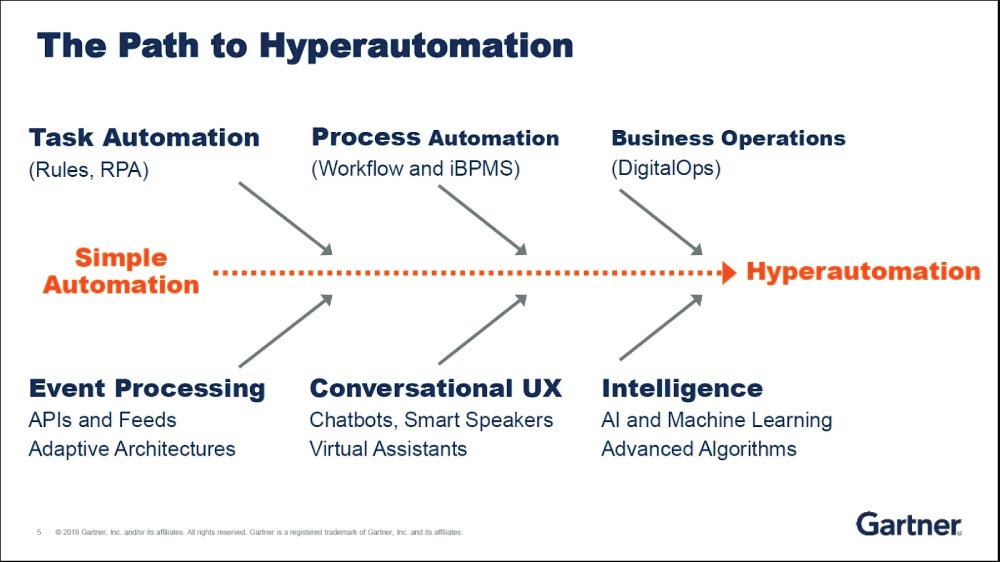It made it into our IT Operations Glossary for 2021 blog last month but got rejected by Wikipedia. Gartner included it in its Top 10 Strategic Technology Trends for 2020 list and business process management software vendor Appian published a book about it.
We’re talking about hyperautomation. Wikipedia’s reservations aside, hyperautomation is a technology trend that’s moving beyond the business process management (BPM) world and into IT operations.
What is hyperautomation?
In our blog we defined it as the “use of advanced technologies, like artificial intelligence (AI), machine learning (ML), and robotic process automation (RPA), to automate tasks that were once done manually.” Hyperautomation refers not just to the tasks and processes that can be automated but the level of automation.
Organizations that elevate their automation game to hyperautomation incorporate innovative new technologies like RPA, machine learning and AI to streamline workflows, boost productivity and make their systems smarter with less human intervention.
5 Steps for Getting Started with Hyperautomation in IT Ops
- Leverage RPA attended or unattended workflows to automate routine operational and housekeeping tasks.
- Automatically correlate alerts at scale using AI for immediate root cause identification.
- Combine decision tables with machine learning for automated first response actions to suppress noisy alerts or to run auto-remediation workflows.
- Predict and prevent incidents through AI/ML driven data analysis to identify and report alert patterns. Integrate with RPA workflows to take preventative actions before users and customers are affected.
- Enrich log events using natural language processing (NLP) to understand their true meaning.
Hyperautomation is automation at scale and at speed, with less human intervention and more advanced analytics."

Business impact of hyperautomation
With remote work the new norm and data volumes ever growing, automating processes with scale, speed and intelligence is becoming table stakes. Think of a power plant that uses machine learning and AI to analyze plant performance data in context with equipment lifecycle data, and then automatically schedules maintenance work accordingly.
Hyperautomation has been more prevalent in the business process management (BPM) world to automate repetitive tasks such as order or invoice processing and purchasing approval workflows:
- Hyperautomation can boost worker productivity increases, cut costs and help everyone be more efficient.
- Job satisfaction levels may also go up as employees no longer wrangle with repetitive tasks.
Hyperautomation in IT operations
The same lessons from the BPM world apply to IT operations. After all, IT has its own processes such as discovery, patch management, user provisioning, incident management and change management. With hyperautomation, problems in IT systems can be detected and resolved faster before users are impacted, making SREs more successful at their jobs.
How can SREs then take advantage of hyperautomation? There is as yet no hyperautomation standards body that certifies this capability, and no off-the-shelf IT hyperautomation platforms. But by combining automation, especially robotic process automation, with AI and machine learning, you can build the foundation for a successful hyperautomation practice.
Summary
Hyperautomation done well can detect, diagnose, troubleshoot and resolve IT incidents at scale and in many cases without human intervention. You’ll be using automation, including RPA, machine learning and AI, to make digital operations a self-driving discipline. You’ll be an even more successful SRE and your business will thank you for it.
The good news is that you don’t have to run out and buy a hyperautomation platform to follow this path. OpsRamp delivers all of this today in its OpsQ platform. To learn more about how to take advantage of AIOps in IT operations, download the OpsRamp State of AIOps Report or schedule a demo to see how OpsRamp can take you to hyperautomation today.



![[Webinar] ITOps to Digital Ops Evolution](https://blog.opsramp.com/hubfs/Blog_images/CTA-ITOps-to-Digital-Ops-Evolution.jpg)


